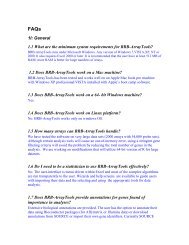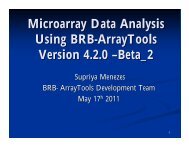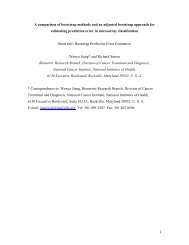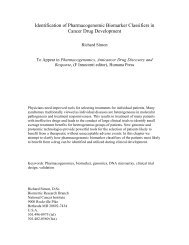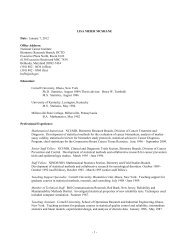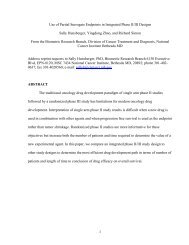Accelerated titration designs - Biometric Research Branch
Accelerated titration designs - Biometric Research Branch
Accelerated titration designs - Biometric Research Branch
You also want an ePaper? Increase the reach of your titles
YUMPU automatically turns print PDFs into web optimized ePapers that Google loves.
--<br />
ACCELERATED TITRATION DESIGNS 109<br />
intrapatient varability, steepness of the dose-toxicity curve and separation of the<br />
dose-toxicity curves for the varing toxicity levels. They also provide all patients<br />
entered in the tral a maximum opportunity to be treated at a therapeutic dose.<br />
Despite this, we find that the <strong>designs</strong> are not widely used, which is likely to<br />
be due to the conservativeness of investigators. Even when they are used, they<br />
are often used with an initial dose set much more conservatively than would be<br />
done for the standard design and without use of intrapatient dose-escalation, thereby<br />
reducing their effectiveness. A recent comprehensive review of the risk-benefit rela-<br />
tionship for phase I trals conducted over the past decade reveals an overall toxicity<br />
death rate of only O.OOS (46). An accompanying editorial (47) argues that<br />
such a low toxicity death rate, in the context of treatment for an often rapidly fatal<br />
disease, suggests that phase I trals may be conducted in an overly cautious<br />
fashion. Appropriate utilization of <strong>designs</strong> such as the accelerated <strong>titration</strong> <strong>designs</strong><br />
might increase the potential for benefit in phase I trals, with little increase in<br />
risk.<br />
References<br />
1. S.G. Arbuck (1996) Workshop on phase I study design. Ninth NCIÆORTC New Drug<br />
Development Symposium, Amsterdam, March 12, 1996. Ann. Oncology, 7(6), 567-<br />
73.<br />
2. E.A. Eisenhauer, P.J. O'Dwyer, M. Christian and J.S. Humphrey (2000). Phase I clinical<br />
tral design in cancer drug development. J. Clin. Oncology, 18(3),684-92.<br />
3. S.P. Dent and E.A Eisenhauer (1996) Phase I tral design: are new methodologies being<br />
put into practice? Ann. Oncology, 7(6), 561-6.<br />
4. L.B. Sheiner (1990) Implications of an alternative approach to dose-response trals. J.<br />
Acquired Immune Deficiency Syndrome, 3(Suppl. 2), 20-.<br />
5. L.B. Sheiner, S.L. Beal and N.e. Sambol (1989) Study <strong>designs</strong> for dose-ranging. Clin.<br />
Pharmacology Theory, 46(1), 63-77.<br />
6. L.B. Sheiner, Y. Hashimoto and S.L. Beal (1991) A simulation study comparng <strong>designs</strong><br />
for dose ranging. Statistics in Medicine, 10(3), 303-21 March.<br />
7. R. Simon, B. Freidlin, L. Rubinstein, S.G. Arbuck, J. Collns and M.e. Chrstian (1997)<br />
<strong>Accelerated</strong> <strong>titration</strong> <strong>designs</strong> for phase I clinical trals in oncology. J. Natl Cancer Inst.,<br />
89(15),1138-47.<br />
8. T.e. Chou and P. Talalay (1981) Generalized equations for the analysis of inhibitions of<br />
Michaelis-Menten and higher-order kinetic systems with two or more mutually exclusive<br />
and nonexclusive inhibitors. Eur. J. Biochemistry, 115(1), 207-16.<br />
9. T.e. Chou and P. Talalay (1984) Quantitative analysis of dose-effect relationships: the<br />
combined effects of multiple drgs or enzyme inhbitors. Adv. Enzyme Regulation, 22,<br />
27-55.<br />
10. P.M. LoRusso, S. Prakash, A. Wozniak, L. Flaherty, M. Zalupski, A Shields, H.<br />
Sands, R. Parchment and B. Jasti (2002) Phase I clinical tral of 5-fluoropyrimidinone<br />
(5FP), an oral prodrg of 5-fluorouracil (5FU). Investigational New Drugs, 20(1), 63-<br />
71.<br />
11. M.P. Goetz, D. Toft, J. Reid, M. Ames, B. Stensgard, S. Safgren, AA. Adjei, J. Sloan, P.<br />
Atherton, V. Vasile, S. Salazaar, A Adjei, G. Croghan and e. Erlichman (2005) Phase I



